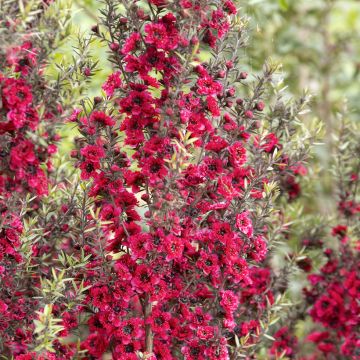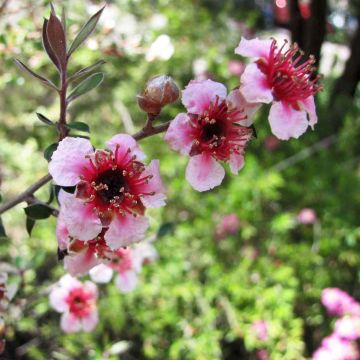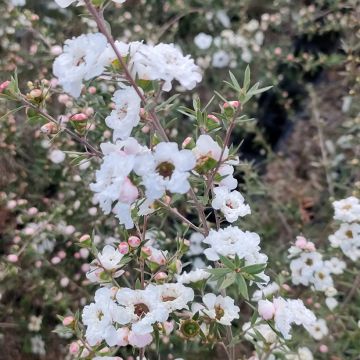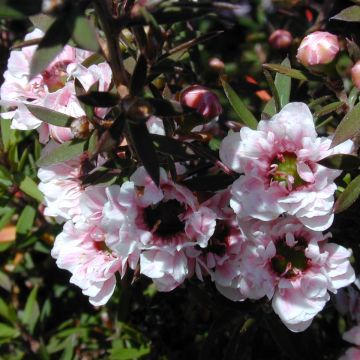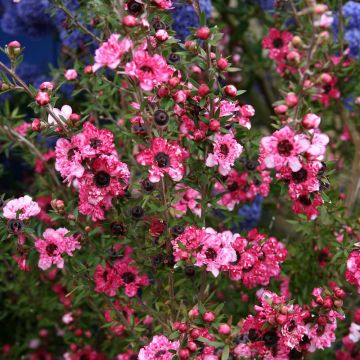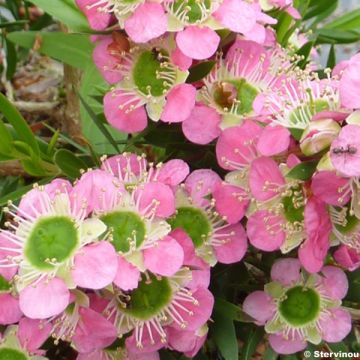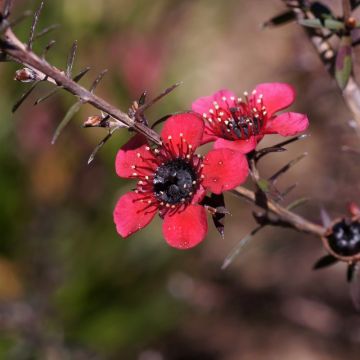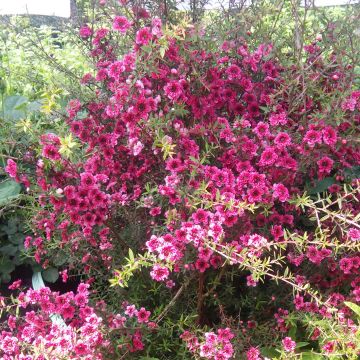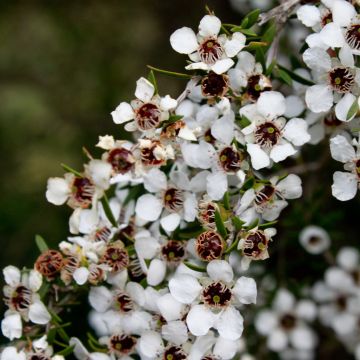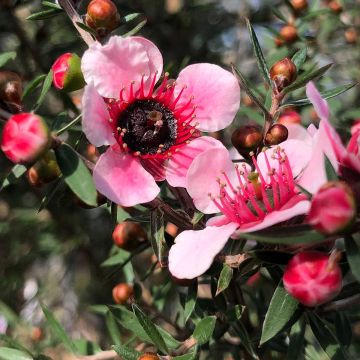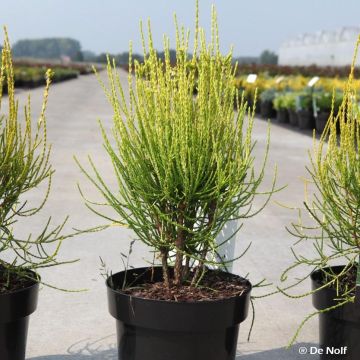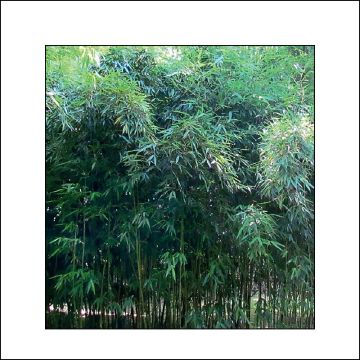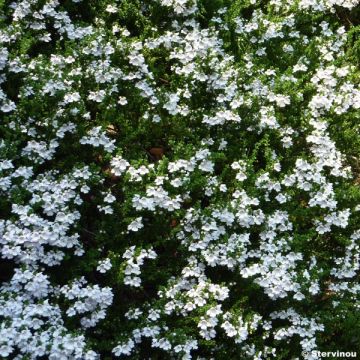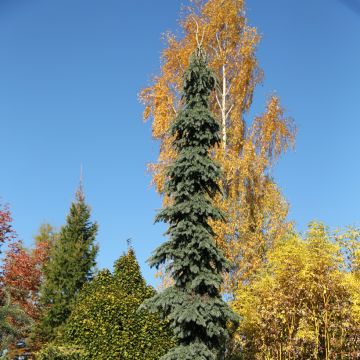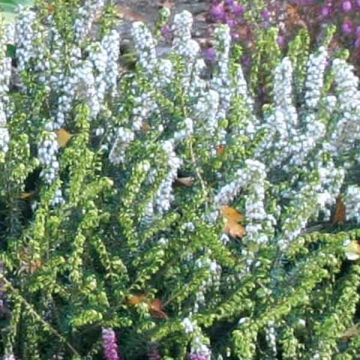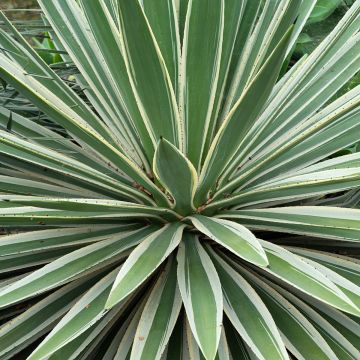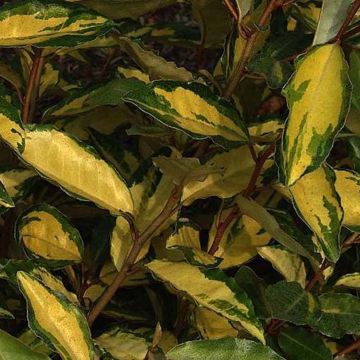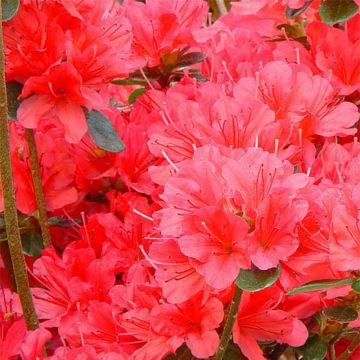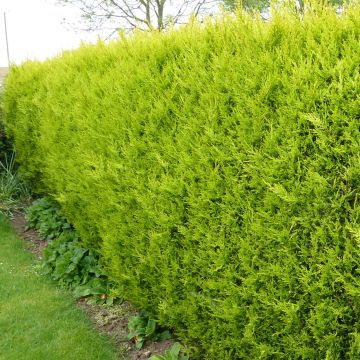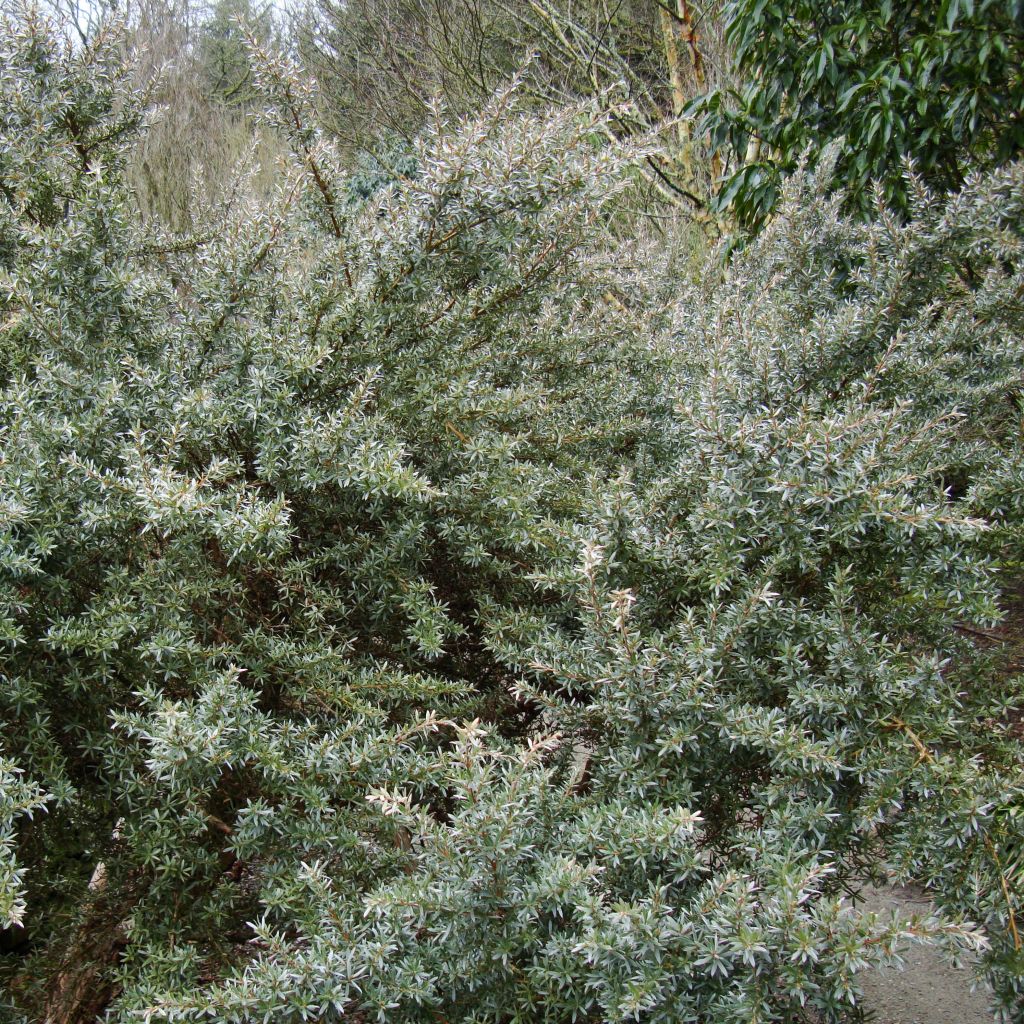

Leptospermum Silver Sheen - Arbre à thé laineux.
Leptospermum lanigerum Silver Sheen - Woolly Tea-tree
Leptospermum lanigerum Silver Sheen
Woolly Tea-tree, New Zealand Tea tree, Manuka
Plant ordered in February. I haven't seen any flowers in this first year but the bush seems to be developing well. That's promising!
Barbara, 06/09/2022
This item cannot be shipped to the selected country
Delivery charge from €5.90
More information
Delivery charge from €5.90
More information
Schedule delivery date,
and select date in basket
This plant carries a 24 months recovery warranty
More information
We guarantee the quality of our plants for a full growing cycle, and will replace at our expense any plant that fails to recover under normal climatic and planting conditions.
From €5.90 for pickup delivery and €6.90 for home delivery
Express home delivery from €8.90.

Does this plant fit my garden?
Set up your Plantfit profile →
Description
Leptospermum Silver Sheen forms a magnificent bush endowed with fine evergreen foliage of a silver-grey colour all year round. It has vigorous and slender vegetation which virtually disappears at the end of spring under a multitude of small white flowers blooming all along its branches. It is an excellent plant for varied evergreen hedges, less demanding and more hardy than most other Leptospermum. It will thrive in a coastal garden, but will tolerate any climate that is not too rigorous. Preferably offer it a good quality soil, well-drained, even a bit sandy, as well as a sunny or partially shaded site.
Leptospermum Silver Sheen is a horticultural derivation of L. lanigerum var. lanigerum, a botanical species known as Woolly tea tree, native to the coastal mountains of New South Wales, Queensland, Victoria state and Tasmania, which bequeathed this bush its small silvery foliage and its lovely ice white flowers. This bush is a cousin of Mediterranean myrtles, clove trees and Eucalyptus. It belongs to the same family, the Myrtaceae, and shares with these plants a love of heat and a tolerance for dry and poor soils. Endowed with a bushy, dense and erect habit, it will reach on average 1.70m (5.5 ft) in height and 1.30m (4 ft) in spread. It is provided with alternate, single, tapering, small leaves, white when budding, later taking on a green hue somewhat masked by numerous silver bristles that give them a woolly appearance. The entire foliage displays a green-grey-silver colour. The flowers, single, honey producing and rich in nectar, appear over 5 to 6 weeks from April to May in warmer climates, later on in colder ones. They are composed of 5 white petals surrounding a green heart and can reach 2 to 3 cm (0.8 to 1.2 in) in diameter. They are followed by small capsules releasing fine elongated seeds. This bush can be lightly pruned after flowering, from May to July.
The 'Silver Sheen' tea tree tolerates temperatures down to -12°C (10.4 °F) but the aerial parts can be damaged from -8°C (17.6 °F). It need a sheltered place, in full but not scorching sun. It copes well with sea spray, which makes it a very beautiful bush for seaside gardens. While it prefers neutral to slightly acid soils, it also tolerates clay-limestone soils according to some experts, as long as they are light, loamy and properly drained.
Leptospermum Silver Sheen can be planted in beds or borders in combination with other Australian or New Zealand shubs such as Callistemon, Grevillea or Melaleuca, but also with South African species: Gomphostigma White Candy, Dierama, Aloe arborescens, Anisodontea capensis or even Melianthus major should enjoy the same growing conditions. It can also be used to create a medium evergreen hedge (not more than 2m (6 to 7 ft) tall) along with Myrtles, large cistus (Cistus laurifolius, Citus (x) aguilari), Feijoa, or Olearia. In regions with very cold winters the plant should be grown in a pot and kept frost-free throughout the winter.
Leptospermum means "thin seed" and takes its common English name of tea tree from Captain Cook and his crew, who used its leaves to prevent scurvy.
Leptospermum lanigerum Silver Sheen - Woolly Tea-tree in pictures
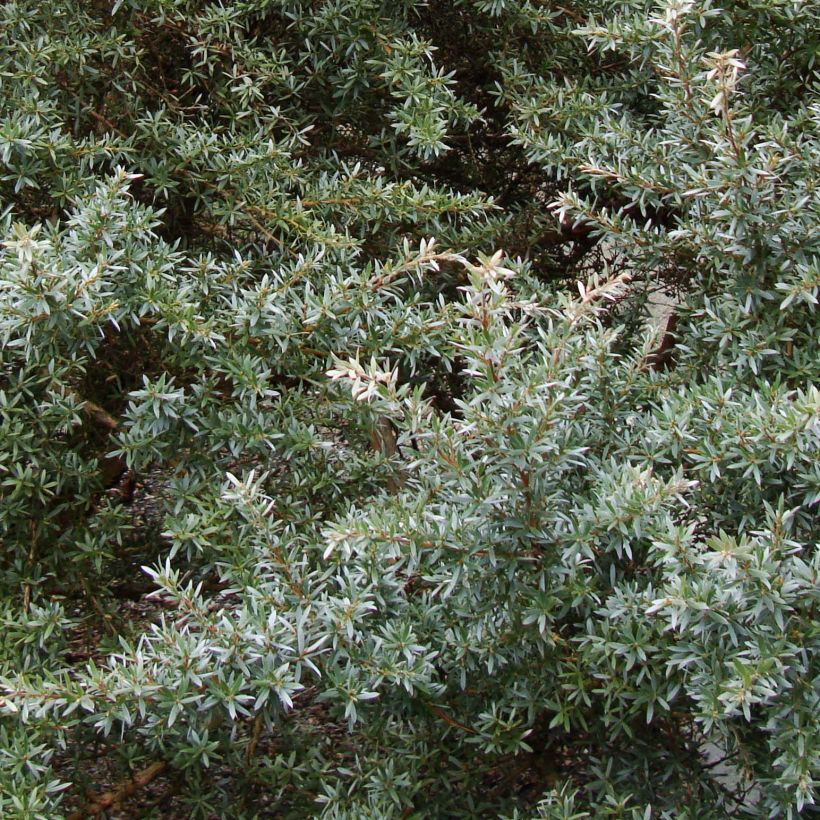

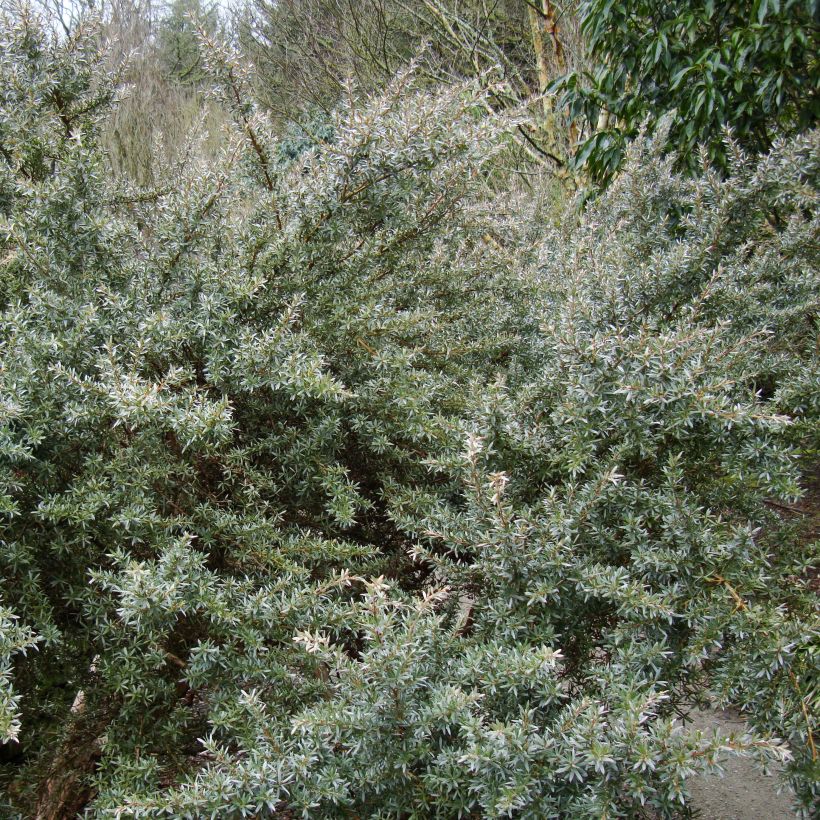

Plant habit
Flowering
Foliage
Botanical data
Leptospermum
lanigerum
Silver Sheen
Myrtaceae
Woolly Tea-tree, New Zealand Tea tree, Manuka
Cultivar or hybrid
Other Leptospermum
Planting and care
Leptospermum Silver Sheen is hardy down to -10/-12°C, and will need protection against cold North and East winds during very harsh winters. It prefers draining to dry soils, light, loamy or sandy, with a neutral or slightly acidic tendency, but is generally quite tolerant. Choose a partially shaded location in a hot climate, or a sunny one in a cooler climate. Prune lightly after flowering (do not remove more than 1/3 from the length of the branches) to maintain a compact habit. It will appreciate an input of extra nutrients in spring (compost or manure), even if not essential since Manuka is adapted to rather poor soils. Let the surface of the root ball dry between waterings and reduce watering in autumn as soon as the temperatures drop. Preferably use non or only slightly calcereous water.
Planting period
Intended location
Care
Evergreen shrubs
Haven't found what you were looking for?
Hardiness is the lowest winter temperature a plant can endure without suffering serious damage or even dying. However, hardiness is affected by location (a sheltered area, such as a patio), protection (winter cover) and soil type (hardiness is improved by well-drained soil).

Photo Sharing Terms & Conditions
In order to encourage gardeners to interact and share their experiences, Promesse de fleurs offers various media enabling content to be uploaded onto its Site - in particular via the ‘Photo sharing’ module.
The User agrees to refrain from:
- Posting any content that is illegal, prejudicial, insulting, racist, inciteful to hatred, revisionist, contrary to public decency, that infringes on privacy or on the privacy rights of third parties, in particular the publicity rights of persons and goods, intellectual property rights, or the right to privacy.
- Submitting content on behalf of a third party;
- Impersonate the identity of a third party and/or publish any personal information about a third party;
In general, the User undertakes to refrain from any unethical behaviour.
All Content (in particular text, comments, files, images, photos, videos, creative works, etc.), which may be subject to property or intellectual property rights, image or other private rights, shall remain the property of the User, subject to the limited rights granted by the terms of the licence granted by Promesse de fleurs as stated below. Users are at liberty to publish or not to publish such Content on the Site, notably via the ‘Photo Sharing’ facility, and accept that this Content shall be made public and freely accessible, notably on the Internet.
Users further acknowledge, undertake to have ,and guarantee that they hold all necessary rights and permissions to publish such material on the Site, in particular with regard to the legislation in force pertaining to any privacy, property, intellectual property, image, or contractual rights, or rights of any other nature. By publishing such Content on the Site, Users acknowledge accepting full liability as publishers of the Content within the meaning of the law, and grant Promesse de fleurs, free of charge, an inclusive, worldwide licence for the said Content for the entire duration of its publication, including all reproduction, representation, up/downloading, displaying, performing, transmission, and storage rights.
Users also grant permission for their name to be linked to the Content and accept that this link may not always be made available.
By engaging in posting material, Users consent to their Content becoming automatically accessible on the Internet, in particular on other sites and/or blogs and/or web pages of the Promesse de fleurs site, including in particular social pages and the Promesse de fleurs catalogue.
Users may secure the removal of entrusted content free of charge by issuing a simple request via our contact form.

































